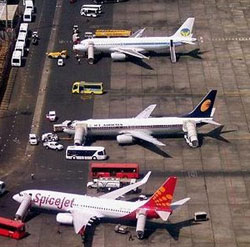Gloomy 2009 outlook for Asian airlines
29 Dec 2008
Traditionally a busy time of the year for Asia-Pacific airlines, the year-end festive season in 2008 has been marked by a worldwide economic slump that has all but cleaned out passenger and cargo traffic for airlines. Now, the industry is bracing for the grey weather forecast for 2009.
In a company newsletter recently, Cathay Pacific CEO Tony Tyler said last December was marked by a "very buoyant mood" that has now been replaced by "very uncertain times" and a mood that is "decidedly sombre."
 Air travel body, The International Air Transport Association (IATA), has also said that the aviation industry is chartering its course through the worst revenue environment in 50 years, even though the decline in fuel prices from their record highs in July 2008 have provided a somewhat temporary breather.
Air travel body, The International Air Transport Association (IATA), has also said that the aviation industry is chartering its course through the worst revenue environment in 50 years, even though the decline in fuel prices from their record highs in July 2008 have provided a somewhat temporary breather.
However, the downward spiral in the global economy has seen air traffic fall as companies and tourists cut back on travel.
Asia-Pacific carriers make up around a third of global passenger traffic, and 45 per cent of the global cargo market. The IATA has said that it would be adversely hit with losses more than doubling from $500 million this year to around $1.1 billion in 2009. Industry experts opine that while regional airlines would most probably to weather the downturn because of their stronger balance sheets and modern fleets, while their American and European peers would be worse off comparatively.
Moreover, airlines including Singapore Airlines, Malaysia Airlines and Chinese carriers are state-run, making them eligible for government support if needed.
Reports also quoted analysts as saying that these regional airlines are faced with less competition than the US and Europe, which has more airlines flying the same routes.
Japanese carriers Japan Air Lines and All Nippon Airways have also slashed revenue forecasts with the nation's economy slowing. Australian, Chinese and South Korean carriers too are reported to be struggling as their economies slow down. Indian carriers are being buffeted by high taxes and insufficient infrastructure, and analysts point out that it would do them well to brace for lower demand in the wake of November's terror attacks on Mumbai.
The IATA has predicted the global air traffic to fall by around three per cent in 2009, marking the first drop since 2001 in the wake of the 11 September attacks on the World Trade Centre that took their toll on the industry. Consequently, capacity rationalisations and layoffs have been the norm to cope with the oil price spike earlier in the year.
Most airlines have tried to stimulate demand during recent weeks by cutting fuel surcharges and offering fare deals as a response to falling fuel prices. (Also see: Jet Airways cuts fares by 15-40 per cent, others to follow in New Year)
These measures, however, fail to camouflage the impending rough weather ahead for the industry. Airlines across Asia have started to brace for 2009, with the largest international cargo carrier Korean Airlines Co. having posted its fourth consecutive quarterly loss during the third quarter on account of a weak Korean won that drove up the cost of fuel and servicing foreign debt.
Cathay Pacific too has booked its first half-year loss since 2003, and has warned that its full-year results would be "disappointing" on account of weakening revenue and losses from fuel hedging. According to reports, the airline plans to mothball two freighters and offer unpaid leave to staff, in addition to postponing the construction of a cargo terminal to cut costs.
It also plans to reduce services to North America, while adding more to Australia, the Middle East and Europe to keep passenger growth flat in 2009 without having to cut destinations.
Singapore Airlines had announced that its third quarter profit dropped 36 per cent, and issued warnings of "weaknesses" in advance bookings for 2009. Japan's All Nippon Airlines cut its net profit forecast for the full year by a third, and put off plans to order a new jumbo aircraft.
Australia's Qantas has also cut 1,500 jobs along with a parallel capacity rationalisation that will be the equivalent of grounding 10 planes, and has shaved by a third its full-year pretax profit target.
China seemed to have had a misstep with the forecast boom in travel during Beijing's Olympics year never having materialised. China's state-run airlines notched up combined losses of 4.2 billion yuan ($613 million) for January-October, hit badly by spiralling fuel costs earlier in the year, and then losing more in fuel hedging after recent drop in prices.
China Eastern, having earlier failed to offload a stake to international investors, is reported to be now looking at merger options with rival Shanghai Airlines, an ally of flag carrier Air China.
India's state-run Air India is also seeking a government bailout to cope with the harsh downturn. Consolidation is predicted as airlines look for mergers and government support to survive the downturn, as it would reduce costs on account of shared resources, and would service more passengers through hubs.
In the US, analysts were reported to be predicting that the major airlines would turn a small profit despite the economic downturn, even though projections have cut during recent months.
Reports said cuts in passenger capacity would stabilise ticket prices, though fee on checked baggage would continue, and would most probably be complimented by some new fee for services as well.







.webp)














